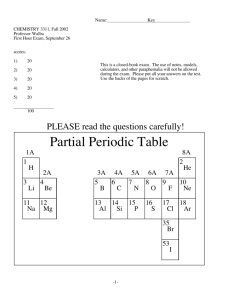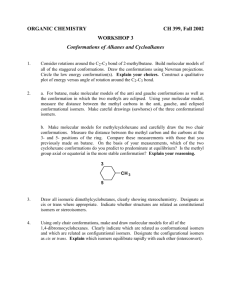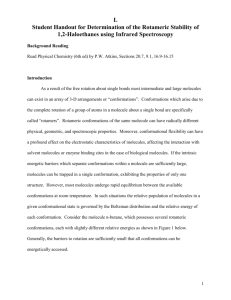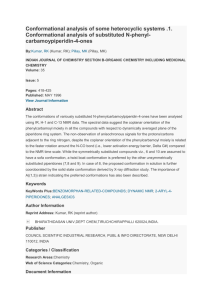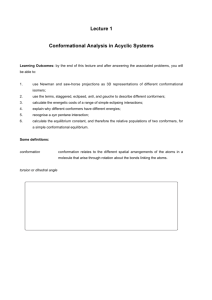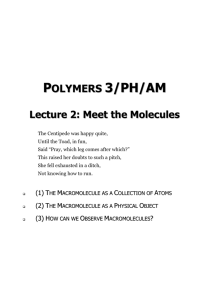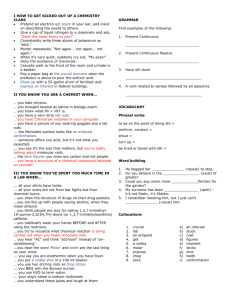Conformational Analysis II
advertisement
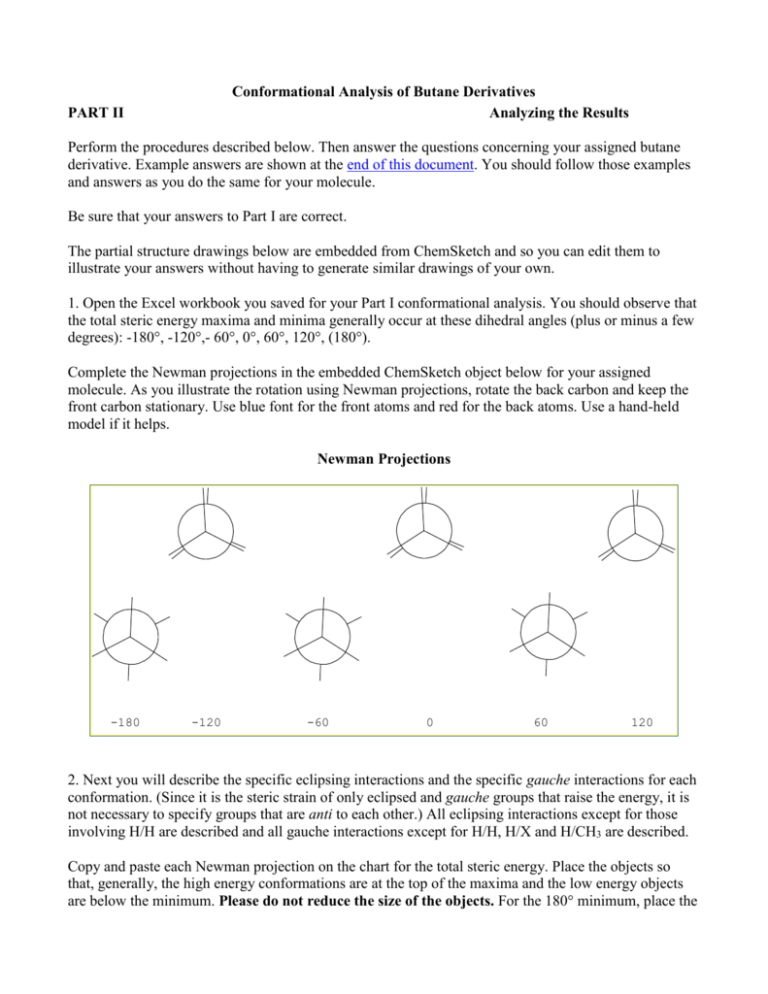
Conformational Analysis of Butane Derivatives Analyzing the Results PART II Perform the procedures described below. Then answer the questions concerning your assigned butane derivative. Example answers are shown at the end of this document. You should follow those examples and answers as you do the same for your molecule. Be sure that your answers to Part I are correct. The partial structure drawings below are embedded from ChemSketch and so you can edit them to illustrate your answers without having to generate similar drawings of your own. 1. Open the Excel workbook you saved for your Part I conformational analysis. You should observe that the total steric energy maxima and minima generally occur at these dihedral angles (plus or minus a few degrees): -180°, -120°,- 60°, 0°, 60°, 120°, (180°). Complete the Newman projections in the embedded ChemSketch object below for your assigned molecule. As you illustrate the rotation using Newman projections, rotate the back carbon and keep the front carbon stationary. Use blue font for the front atoms and red for the back atoms. Use a hand-held model if it helps. Newman Projections -180 -120 -60 0 60 120 2. Next you will describe the specific eclipsing interactions and the specific gauche interactions for each conformation. (Since it is the steric strain of only eclipsed and gauche groups that raise the energy, it is not necessary to specify groups that are anti to each other.) All eclipsing interactions except for those involving H/H are described and all gauche interactions except for H/H, H/X and H/CH3 are described. Copy and paste each Newman projection on the chart for the total steric energy. Place the objects so that, generally, the high energy conformations are at the top of the maxima and the low energy objects are below the minimum. Please do not reduce the size of the objects. For the 180° minimum, place the object below the minimum curve on the left (the minimum is split between the left and right sides of the plot.) Be sure the name and condensed molecular structure for your molecule appears on the chart. The example for butane is shown at the end of the document. 3. You now have to determine which of your compound’s conformations, if any, have identical gauche interactions. Then, for the non-identical gauche interactions, which interaction(s) cause the difference in the conformation's calculated energies. The same procedure is followed for the eclipsing interactions. Copy the table below and paste it into a new Excel worksheet name "Analysis". Adjust the column widths as necessary to accommodate your answers. As you did on the chart, put the name and condensed structure of your assigned molecule on the sheet. Enter the interactions for each conformation. These should match the interactions that are shown in your Newman projections embedded on the total energy chart. The example for butane is shown at the end of the document. Eclipsed Dihedral angle Eclipsing interactions -120 0 120 Staggered Dihedral angle Gauche interactions -180 -60 60 Questions: a) From your table of the specific gauche and eclipsed interactions in each conformation, explain what causes the total steric energy level differences (or no difference) for the eclipsed conformations and the energy level differences (or no difference) for the staggered conformations. A systematic explanation involves cancelling terms and making comparisons between pairs of conformations as explained further in the "more complicated example" after the butane answers at the end of this document. b) What conformation(s) have the largest contribution from non-1,4-van der Waals energy according to your calculations from Chem3D? Specify at least one set of atoms involved in the non-1,4-van der Waals interaction in that conformation of your molecule. c) What conformation(s) have the largest contribution from the dipole energy term (either positive or negative)? If your molecule did not have dipole-dipole interactions, state so. Answer the questions posed in dark blue font in step 3, above. Compose the answers in Word, and then embed the Word answer in the "Analysis" worksheet, as in the butane example at the end of this document. Size the object box so that you can print the "Analysis" worksheet on one page, whether or not the embedded text is readable. Print the entire answer from Word to submit with your assignment. Submitting the assignment: Answers should be in the Excel workbook. Save it as conf2-XXX.xls where XXX are your initials. The answers to question 3, above, should be in a Word document, conf2-XXX.doc where XXX are your initials. Print the new charts/sheets from Excel, using the same custom header/footers as for Part I. Print the Word answer with your name in the header. Make sure that your printout is legible and that all details of the chart print with sufficient contrast so I can read it. If your printer needs ink, please refill it before printing. Turn in the printouts and submit the documents to WebCT. Example answers for butane: The easiest way to build the Newman projections is to use the atom label tool. Insert a group that you will be using in all your drawings on the sketch space. Then copy the label as many times as you need it and place it in the appropriate place in every Newman projection. You can move the label in small increments by selecting it and then using the arrow keys to move the object precisely. When you are finished with each Newman projection, select all elements of the projection and Group them so they stay together. Step 1: Constructing the Newman projections Conformational Energy Diagram for Butane, CH3-CH2-CH2-CH3 CH 3 CH 3 CH 3 H CH 3 H H CH 3 H H H H CH 3H H H H CH 3 H CH 3 CH 3 CH 3 H CH 3 H H CH 3 H H H H CH 3 H H H H H H H CH 3 -180 -120 -60 0 60 120 Step 2: Defining the eclipsing and gauche interactions Gauche and Eclipsing Interactions for CH3-CH2-CH2-CH3 eclipsing CH 3 CH 3 eclipsing H CH 3 H eclipsing eclipsing H H H CH 3H H H H CH 3 eclipsing CH 3 CH 3 H H gauche gauche CH 3 CH 3 H H CH 3 H H H H CH 3 H H H H H H H CH 3 -180 -120 -60 0 60 120 These are the objects that you copy and paste on your Excel total energy chart. Here is an example (double-click the embedded chart). 11 Total Steric Energy vs. Dihedral Angle n-Butane CH3eclipsing -CH2-CH2-CH3 10 CH 3 9 CH 3 eclipsing 8 eclipsing CH 3 H H Steric Energy (kcal) 7 eclipsing 6 H CH 3 H CH 3H H H H H H eclipsing 5 4 gauche 3 gauche CH 3 2H CH 3 CH 3 CH 3 H H H H CH 3 H H 1H 0 CH 3 H H H H H H CH 3 -180 -150 -120 -90 -60 Dihedral Angle (degrees) -30 0 30 60 90 120 150 180 Step 3: Analyzing the interactions Eclipsing interactions are easiest. From left to right in the butane example, the eclipsing interactions are shown in the table. Gauche staggered interactions are a bit more complicated. Start anywhere on a Newman projection and inspect each pair of groups that have 60° dihedral angles. Proceed around the projection to find a gauche relationship that does not involve H and label each one until you come back to your starting point. From left to right in the butane example the gauche interactions are shown in the table. Eclipsed Dihedral angle Eclipsing interactions Staggered Dihedral angle Gauche interactions -120 two Me/H 0 one Me/Me 120 two Me/H -180 -60 one Me/Me 60 one Me/Me none a) In eclipsed butane, two conformations have identical interactions (Me/H). The third eclipsed conformation has (Me/Me). The conformation with the (Me/Me) interaction is higher in energy (as seen in the Excel graph). The Me is a larger group than H. Thus, you would conclude that the Me/Me interaction causes steric strain (probably 1,4- and non-1,4-vdW) and increases the energy of the 0 deg. conformation relative to the 120 deg. conformations. Since the two 120 deg. conformations are identical, their energy levels are identical. For staggered butane, there are two conformations that have identical gauche interactions (Me/Me). The third conformation (where the Me's are anti to each other) has no gauche interactions. Since the Me is a larger group than H, the Me/Me gauche interaction raises the energy of the 60 deg. conformations relative to the 180 deg. conformation. Since they are identical interactions, the energy levels are identical. b) From the butane Excel charts, the largest non-1,4-vdW energy occurs at 0 deg. eclipsed conformation. The atoms involved could be the H-C1-C2-C3-C4-H atoms, that is, the H’s on the methyl groups which are 1,6 atoms apart. c) There are no dipole changes reported for butane. A more complicated example is shown here. For the staggered conformations of a trisubstituted butane (CH3-CHX-CX2-CH3), there are four gauche interactions in each conformation. (Remember, do not count H's as gauche interactions.) Me/X Me/X CH 3 X Me/X Me/Me CH 3 CH 3 CH 3 X CH 3 CH 3 X/X H X X X X/X H Me/Me Me/X Me/X H X X X Me/X X X/X -180o X/X 60o -60o Gauche and Eclipsing Interactions for CH3CHX-CX2CH3 Staggered Dihedral angle (CH3-C-C-CH3) Gauche interactions -180 three Me/X one X/X -60 one Me/X one Me/Me two X/X 60 two Me/X one Me/Me one X/X However, they are not all identical and so they likely have different energies. “Subtract” the gauche interactions in two conformations so that the interactions that are common to both are canceled out. Then analyze the remaining gauche interactions. For example, the 60 deg. conformation’s interactions are shown within the top set of brackets and the -180 deg. conformation’s interactions are shown within the bottom set of brackets. Cancel the common interactions and then write the net result: [2 Me/X – [3 Me/X Me/Me X/X] X/X] Net: Me/Me for the 60 deg. conformation vs. Me/X for the -180 deg. conformation. To complete the analysis, you need to know which is larger, Me or X, and the answer, of course, depends on X. Generally (and this is a deduction from conformational analysis!), Me and I are about the same size and the other halogens decrease in size going up the Group. If X = I, then the groups are about the same size and an Me/Me interaction has about the same energy as an Me/I interaction. You might expect the -180 deg. and 60 deg. conformations to be at about the same energy level. If X = F, then the steric repulsion between Me/Me is greater than for Me/F. You might expect the 60 deg. conformation to have more steric strain than the -180 deg. conformation and thus be at a higher energy level. This is one “pair-wise” comparison (between -180deg. and 60 deg.). There are three staggered conformations, and so there should be three pair-wise comparisons (also -180 and -60; -60 and 60). There are also three pair-wise comparisons for the three eclipsed conformations. Proceed for each of your conformations and analyze each pair in the same way: summarize the interactions, cancel the common interactions, if any, then on the basis of the size of the interacting groups and the resulting steric strain, account for the energy difference of each pair. Your analysis should completely explain the energy levels in the total energy chart. Chemistry 350 George Mason University http://classweb.gmu.edu/sslayden/Chem350/chem350.htm
